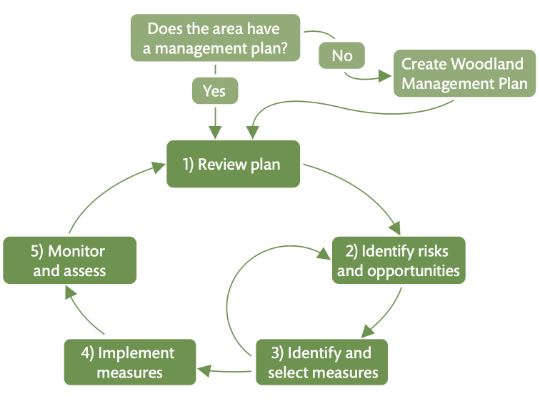Northern Ireland
In Northern Ireland, woodland area currently represents 8.5% of the total land area (Forest Research, 2022) and this is increasing.
The warming climate may increase productivity where other factors are non-limiting. However, careful selection of tree species and management will be important, particularly on exposed sites and in areas that will become susceptible to summer drought.
Climate change projections and impacts
The climate is expected to change in Northern Ireland, resulting in a warmer climate which could lead to increased productivity in some tree species (where other factors are non-limiting). However, an increase in the frequency of storms will affect exposed sites, and the projected drier summer and wetter winter climate is likely to lead to more frequent summer drought episodes. Although the anticipated changes in summer conditions are not expected to be as pronounced as in other parts of Ireland, careful selection of tree species and provenance on sites which could be prone to drought will be important, particularly in parts of Counties Down and Armagh, and in areas where there will be increased fluctuation in the depth of the water table, affecting rooting depth.

Adaptation
Selection of suitable adaptation measures will depend on the site in question. The steps presented in the 5-Step Adaptation Framework will support decision-making. For example, moving away from clearfelling and favouring low impact silviculture systems, including continuous cover forestry, is one important option which could help manage a range of climate risks.
Adopting low impact silvicultural systems will be particularly important on free-draining and sheltered sites where they can help attenuate changes in temperature and water regimes that occur with clearfelling (Ray et al., 2007).
The changing climate, coupled with pest and disease outbreaks, is already affecting the range of tree species suitable for Northern Ireland. Research into ‘minor’ conifer species suggests species such as Scots pine and Douglas fir could be increasingly used on drier sites and western red cedar for wetter sites in Ireland. There will also be opportunities to increase the use of tree species and provenances from more southerly latitudes, subject to regular analysis of pest and disease risk.
An increase in the frequency of extreme events is expected, particularly storm frequency and average wind speed. Adapting silviculture to the changing wind regime is therefore an important and significant challenge, particularly when considering thinning and timing of operations.
The UKFS Practice Guide ‘Adapting forest and woodland management to the changing climate’
Download the UKFS Adaptation Practice Guide
Printed copies are available to purchase from Forest Research.
"*" indicates required fields
Information on the National Adaptation Programme in Northern Ireland is available on the DAERA website.
Tree health
You can use TreeCheck to report evidence of suspected disease or insect damage on trees to DAFM or DAERA for investigation. The TreeCheck App will help in the early detection of new and existing harmful pests and diseases.



